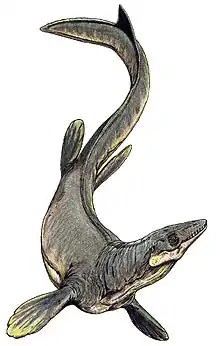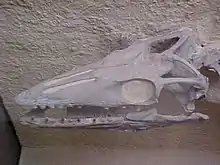Plioplatecarpinae
Plioplatecarpinae is a subfamily of mosasaurs, a diverse group of Late Cretaceous marine squamates. Members of the subfamily are informally and collectively known as "plioplatecarpines" and have been recovered from all continents,[3] though the occurrences in Australia remain questionable. The subfamily includes the genera Latoplatecarpus, Platecarpus, Plioplatecarpus and Plesioplatecarpus.
| Plioplatecarpinae Temporal range: Late Cretaceous
| |
|---|---|
 | |
| Skeleton cast of Platecarpus tympaniticus | |
| Scientific classification | |
| Domain: | Eukaryota |
| Kingdom: | Animalia |
| Phylum: | Chordata |
| Class: | Reptilia |
| Order: | Squamata |
| Superfamily: | †Mosasauroidea |
| Family: | †Mosasauridae |
| (unranked): | †Russellosaurina |
| Subfamily: | †Plioplatecarpinae Dollo, 1884;[1] Williston, 1897[2] |
| Genera | |
Plioplatecarpines were small to medium-sized mosasaurs that were comparatively fast and agile compared to mosasaurs of other subfamilies. The first plioplatecarpines appear in the Turonian and are among the oldest of mosasaurs, and the clade persists throughout the Maastrichtian, a period of approximately 24 million years. The subfamily was seemingly heavily affected during a poorly understood middle-Campanian mosasaur extinction event[4] and its genera appear to have faced competition from mosasaurine mosasaurs during the Maastrichtian, leading to a decline in numbers and in diversity.[5]
The etymology of this group derives from the genus Plioplatecarpus (Greek pleion = "more" + Greek plate = "oar" + Greek karpos = "wrist, carpus").
Description

In general, plioplatecarpines were short-skulled, short-bodied forms and were among the strongest swimming mosasaurs . Some workers have likened them to pinnipeds in their agility . Most forms were likely piscivores ("fish eaters"), though cephalopods (belemnites) evidently formed an important part of the plioplatecarpine diet. Larger forms may have also fed upon smaller marine reptiles. At least one genus evolved sturdy crushing teeth adapted to feeding on shellfish. The plioplatecarpines were medium-sized mosasaurs ranging from around 2.5 to 7.5 meters in length.
Russell (1967, pp. 148[6]) defined the Plioplatecarpinae as follows: Small rostrum present or absent anterior to premaxillary teeth. Cranial nerves X, XI, XII leave lateral wall of opisthotic through single foramen. Canal or deep groove in floor of basioccipital and basispehnoid for basilar artery. Suprastapedial process of quadrate large, bluntly terminated and with parallel sides. Dorsal edge of surangular rounded and longitudinally horizontal...Twenty-nine or less presacral vertebrae present. Length of presacral series less than that of postsacral, neural spines of posterior caudal vertebrae at most only slightly elongated, do not form an appreciable fin. Haemal arches usually unfused to caudal centra. Appendicular elements lack smoothly finished articular surfaces."
Phylogeny

Russell[6] included two tribes, the Plioplatecarpini and Prognathodontini, the latter of which has been reassigned by Bell[7] to the Mosasaurinae.
Polcyn and Bell (2005, p. 322[8]) have erected a more inclusive clade, the parafamily Russellosaurina, which includes the "subfamilies Tylosaurinae and Plioplatecarpini and their sister-clade containing the genera Tethysaurus, Russellosaurus, and Yaguarasaurus."
The cladogram below is synthesized from Strong et al. (2020),[9] Willman et al. (2021),[10] Cuthbertson & Holmes (2015),[11] and Madzia & Cau (2017).[12][lower-alpha 1]
| |||||||||||||||||||||||||||||||||||||||||||||||||||||||||||||||||||||||||||||||||||||||||||||||||||||||||||||
Species and taxonomy
Plioplatecarpinae
- Angolasaurus
- A. bocagei
- Ectenosaurus
- E. clidastoides
- Gavialimimus
- G. almaghribensis
- Selmasaurus
- S. russelli
- S. johnsoni
- Plioplatecarpini
- Latoplatecarpus
- L. nichollsae
- L. willistoni
- Platecarpus
- P. tympaniticus
- Plesioplatecarpus
- P. planifrons
- Plioplatecarpus
- P. primaevus
- P. houzeaui
- P. marshii
- Latoplatecarpus
Notes
- Clade containing Angolasaurus bocagei and inclusive is modified from Strong et al. (2020). Clade containing Ectenosaurus and clade Platecarpus tympaniticus and inclusive follow Willman et al. (2021) and Cuthbertson & Holmes (2015). Plesioplatecarpus planiforms is represented as unresolved as placement is conflicting between both the three studies. Higher taxa is based on Madzia & Cau (2017).
References
- Dollo L. 1884. Le mosasaure. Revue des Questions Scientifiques XVI:648-653.
- Williston SW. 1897. Range and distribution of the mosasaurs with remarks on synonymy. Kansas University Quarterly 4 (4): 177-185.
- "Fossilworks: Plioplatecarpinae". fossilworks.org. Retrieved 17 December 2021.
- "Stratigraphical distribution of Campanian and Maastrichtian mosasaurs in Sweden - Evidence of an intercontinental marine extinction event?". ResearchGate. Retrieved 2017-09-11.
- Polcyn, Michael J.; Jacobs, Louis L.; Araújo, Ricardo; Schulp, Anne S.; Mateus, Octávio (2014-04-15). "Physical drivers of mosasaur evolution". Palaeogeography, Palaeoclimatology, Palaeoecology. Physical drivers in the evolution of marine tetrapods. 400: 17–27. Bibcode:2014PPP...400...17P. doi:10.1016/j.palaeo.2013.05.018.
- Russell DA. 1967. Systematics and morphology of American mosasaurs. Peabody Museum of Natural History, Yale University, Bulletin 23.
- Bell GL. Jr. 1997. A phylogenetic revision of North American and Adriatic Mosasauroidea. pp. 293-332 In: Callaway JM, Nicholls EL, (eds.), Ancient Marine Reptiles, Academic Press, 501 pp.
- Polcyn MJ, Bell GL. Jr. 2005. Russellosaurus coheni n. gen., n. sp., a 92 million-year-old mosasaur from Texas (USA), and the definition of the parafamily Russellosaurina. Netherlands Journal of Geosciences 84 (3): 321-333.
- Catherine R. C. Strong, Michael W. Caldwell, Takuya Konishi & Alessandro Palci (2020) A new species of longirostrine plioplatecarpine mosasaur (Squamata: Mosasauridae) from the Late Cretaceous of Morocco, with a re-evaluation of the problematic taxon ‘Platecarpus’ ptychodon, Journal of Systematic Palaeontology, 18:21, 1769-1804, DOI: 10.1080/14772019.2020.1818322
- Alexander J. Willman, Takuya Konishi, and Michael W. Caldwell. 2021. A new species of Ectenosaurus (Mosasauridae: Plioplatecarpinae) from western Kansas, USA, reveals a novel suite of osteological characters for the genus1. Canadian Journal of Earth Sciences. 58(9): 741-755.
- Robin S. Cuthbertson & Robert B. Holmes (2015) A new species of Plioplatecarpus (Mosasauridae, Plioplatecarpinae) from the Bearpaw Formation (Campanian, Upper Cretaceous) of Montana, U.S.A., Journal of Vertebrate Paleontology, 35:3, DOI: 10.1080/02724634.2014.922980
- Daniel Madzia; Andrea Cau (2017). "Inferring 'weak spots' in phylogenetic trees: application to mosasauroid nomenclature". PeerJ. 5: e3782. doi:10.7717/peerj.3782. PMC 5602675. PMID 28929018.